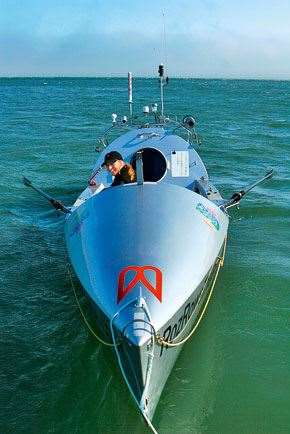A decade ago, Roz Savage, a 34-year-old London office worker, decided to undergo an odd piece of self-: analysesshe sat down and wrote two versions of her own obituary.
 Nothing high-tech about her boat. Especially its engine. Images: Courtesy of Roz Savage
Nothing high-tech about her boat. Especially its engine. Images: Courtesy of Roz SavageStarting Out
“For the Atlantic I trained really, really hard. I was determined there’d be no surprises for my body when I arrived at the start line. So I trained for up to 30 hours a week – a combination of running, cross-training, weight training and many hours on my WaterRower.
“My training peaked two months before I left. For five consecutive Sundays I spent 16 hours on the rowing machine, rowing four shifts of four hours with a one-hour break in between. I’d start at noon on a Sunday and finish around breakfast on a Monday. It was as much about training my boredom threshold as anything else. I passed the time listening to music and visualising what it would be like to row across an ocean.
“Was it a successful strategy? Yes – in that it got me to the start line believing I had the physical stamina to cope with this challenge. No – in that within the first week I developed tendonitis in my shoulders and spent most of the crossing relying on painkillers.
“The problem was due to the fact that the rowing motion on the WaterRower was consistent and regular, while in the open ocean I was lucky if I got both the oars in the water at the same time and those shockwaves were transmitted straight into my shoulders. I found that while a rowing machine stroke derives 80 per cent of its power from the thigh muscles, on the ocean I was using my upper body much more. The rougher the water, the less I was able to use the bigger, stronger thigh muscles, and the more I had to rely on my lats and deltoids.
“For that crossing, it would probably have helped if I’d spent less time on the rowing machine and more time in my boat, but the boat was in the boatyard being fitted out, so this wasn’t an option at the time. There are also significant logistical challenges with getting the boat in the water on a regular basis – having a vehicle with a towbar, finding a boat ramp, having an escort boat in case of a strong headwind. It’s not that easy to get out in the boat whenever I like. Training in an open water sculling boat would’ve been a good alternative.”
Learning the Craft
“Probably one of the best things I did during my preparations for the Atlantic was to spend a total of six weeks at sea in relatively small sailing boats. For four weeks I sailed on a Sigma 38 in the Eastern Atlantic, from Cape Verde to the Azores. The plan was then to sail back to the UK, but the weather was too hostile, so we just did a two-week loop to the north of the Azores. These six weeks gave me invaluable experience in a whole range of things: using marine instruments, developing navigation skills, keeping watch overnight, the psychological impact of being out of sight of land. And, of course, it gave me a good taste of sea-sickness and how to survive it.”
Related Articles

Morri: Golf at Riviera is golf worth watching

Review: Titirangi Golf Club













